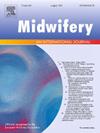Healthcare professionals’ perceptions of barriers and facilitators to postpartum diabetes screening participation in women with gestational diabetes mellitus in China: A qualitative study
IF 2.5
3区 医学
Q1 NURSING
引用次数: 0
Abstract
Background
Women with a history of gestational diabetes mellitus (GDM) have a higher risk of developing type 2 diabetes (T2DM). Postpartum diabetes screening is usually recommended to identify glucose intolerance and introduce timely diabetes prevention strategies. However, the uptake of postpartum diabetes screening is suboptimal, especially in China, where GDM is prevalent. Healthcare professionals (HCPs) may offer unique insights into the challenges women face when attending screening, helping to develop interventions that improve uptake and fit in with routine clinical practice.
Aim
To explore HCPs’ perceptions of barriers and facilitators to postpartum diabetes screening uptake.
Methods
Online semi-structured interviews were conducted with HCPs recruited via online networks. The data were analysed using framework analysis and the socio-ecological model.
Results
Eighteen HCPs, including obstetricians, midwives, nurses, nurse managers, and a dietician participated. Thirteen themes were generated across four levels (individual, interpersonal, organisational and policy). Individual level themes included: women’s limited understanding, adherence and motivation; low diabetes risk awareness; and competing priorities. Interpersonal challenges involved communication and relationships between HCPs and women. Organizational barriers included workforce shortages, a lack of systemic GDM follow-up and care integration, and limited screening accessibility. At the policy level, GDM follow-up was not promoted nor prioritised.
Conclusion
HCPs have a vital role in improving patient education, postpartum follow-up and support after GDM to reduce long-term health risks. Strengthening HCP training in communication with women and improving continuity and integration of care could enhance GDM follow-up and prevent diabetes in women following GDM.
中国妊娠期糖尿病妇女参与产后糖尿病筛查的障碍和促进因素:一项定性研究
背景有妊娠糖尿病(GDM)病史的妇女患 2 型糖尿病(T2DM)的风险较高。通常建议进行产后糖尿病筛查,以确定葡萄糖不耐受情况并及时采取糖尿病预防策略。然而,产后糖尿病筛查的普及率并不理想,尤其是在中国,因为中国的 GDM 发病率很高。目的 探讨医护人员对产后糖尿病筛查的障碍和促进因素的看法。方法 对通过网络招募的医护人员进行在线半结构式访谈。结果包括产科医生、助产士、护士、护士经理和一名营养师在内的 18 名高级保健人员参加了访谈。在四个层面(个人、人际、组织和政策)共产生了 13 个主题。个人层面的主题包括:妇女的理解、坚持和动力有限;对糖尿病风险的认识不足;优先事项相互竞争。人际层面的挑战涉及保健医生和妇女之间的沟通和关系。组织方面的障碍包括劳动力短缺、缺乏系统的 GDM 随访和护理整合,以及筛查的可及性有限。在政策层面,GDM 的随访既没有得到推广,也没有被列为优先事项。加强保健人员与妇女沟通方面的培训,改善护理的连续性和整合性,可以加强 GDM 随访,预防 GDM 妇女患糖尿病。
本文章由计算机程序翻译,如有差异,请以英文原文为准。
求助全文
约1分钟内获得全文
求助全文
来源期刊

Midwifery
医学-护理
CiteScore
4.50
自引率
7.40%
发文量
221
审稿时长
13.4 weeks
期刊介绍:
Midwifery publishes the latest peer reviewed international research to inform the safety, quality, outcomes and experiences of pregnancy, birth and maternity care for childbearing women, their babies and families. The journal’s publications support midwives and maternity care providers to explore and develop their knowledge, skills and attitudes informed by best available evidence.
Midwifery provides an international, interdisciplinary forum for the publication, dissemination and discussion of advances in evidence, controversies and current research, and promotes continuing education through publication of systematic and other scholarly reviews and updates. Midwifery articles cover the cultural, clinical, psycho-social, sociological, epidemiological, education, managerial, workforce, organizational and technological areas of practice in preconception, maternal and infant care.
The journal welcomes the highest quality scholarly research that employs rigorous methodology. Midwifery is a leading international journal in midwifery and maternal health with a current impact factor of 1.861 (© Thomson Reuters Journal Citation Reports 2016) and employs a double-blind peer review process.
 求助内容:
求助内容: 应助结果提醒方式:
应助结果提醒方式:


